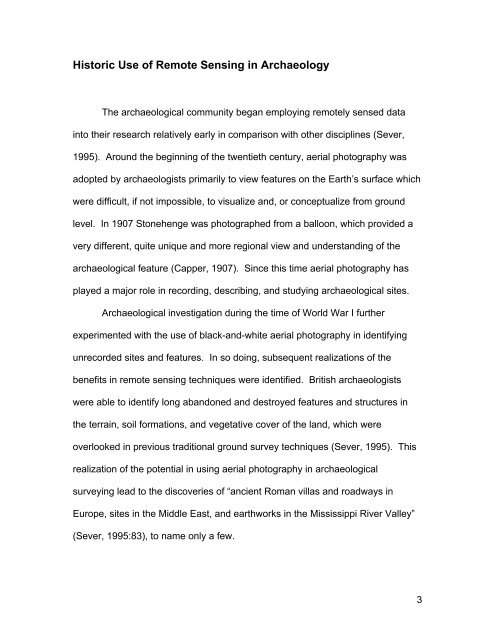A Review of Remote Sensing Application in Archaeological Research
A Review of Remote Sensing Application in Archaeological Research
A Review of Remote Sensing Application in Archaeological Research
Create successful ePaper yourself
Turn your PDF publications into a flip-book with our unique Google optimized e-Paper software.
Historic Use <strong>of</strong> <strong>Remote</strong> <strong>Sens<strong>in</strong>g</strong> <strong>in</strong> Archaeology<br />
The archaeological community began employ<strong>in</strong>g remotely sensed data<br />
<strong>in</strong>to their research relatively early <strong>in</strong> comparison with other discipl<strong>in</strong>es (Sever,<br />
1995). Around the beg<strong>in</strong>n<strong>in</strong>g <strong>of</strong> the twentieth century, aerial photography was<br />
adopted by archaeologists primarily to view features on the Earth’s surface which<br />
were difficult, if not impossible, to visualize and, or conceptualize from ground<br />
level. In 1907 Stonehenge was photographed from a balloon, which provided a<br />
very different, quite unique and more regional view and understand<strong>in</strong>g <strong>of</strong> the<br />
archaeological feature (Capper, 1907). S<strong>in</strong>ce this time aerial photography has<br />
played a major role <strong>in</strong> record<strong>in</strong>g, describ<strong>in</strong>g, and study<strong>in</strong>g archaeological sites.<br />
<strong>Archaeological</strong> <strong>in</strong>vestigation dur<strong>in</strong>g the time <strong>of</strong> World War I further<br />
experimented with the use <strong>of</strong> black-and-white aerial photography <strong>in</strong> identify<strong>in</strong>g<br />
unrecorded sites and features. In so do<strong>in</strong>g, subsequent realizations <strong>of</strong> the<br />
benefits <strong>in</strong> remote sens<strong>in</strong>g techniques were identified. British archaeologists<br />
were able to identify long abandoned and destroyed features and structures <strong>in</strong><br />
the terra<strong>in</strong>, soil formations, and vegetative cover <strong>of</strong> the land, which were<br />
overlooked <strong>in</strong> previous traditional ground survey techniques (Sever, 1995). This<br />
realization <strong>of</strong> the potential <strong>in</strong> us<strong>in</strong>g aerial photography <strong>in</strong> archaeological<br />
survey<strong>in</strong>g lead to the discoveries <strong>of</strong> “ancient Roman villas and roadways <strong>in</strong><br />
Europe, sites <strong>in</strong> the Middle East, and earthworks <strong>in</strong> the Mississippi River Valley”<br />
(Sever, 1995:83), to name only a few.<br />
3
















